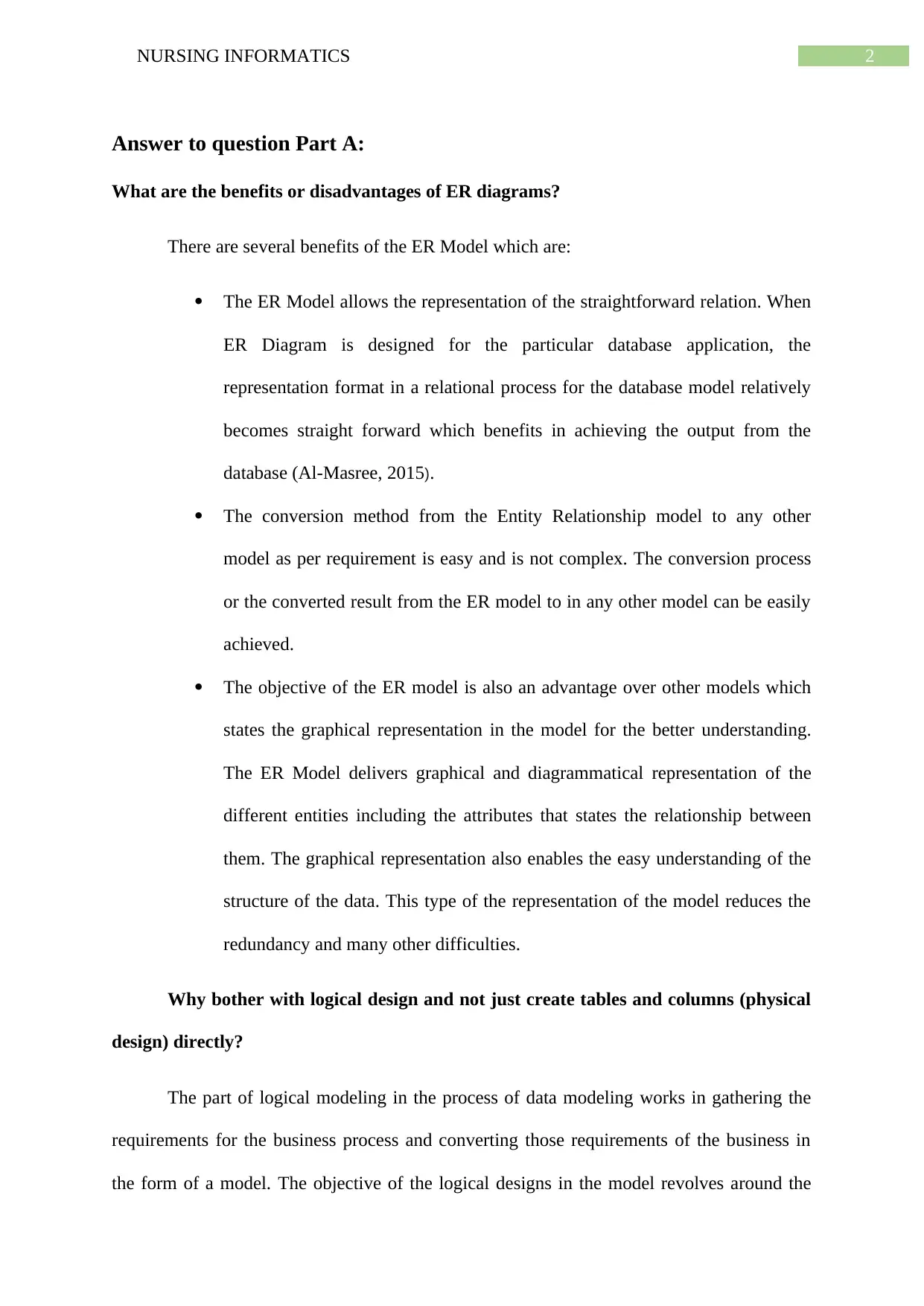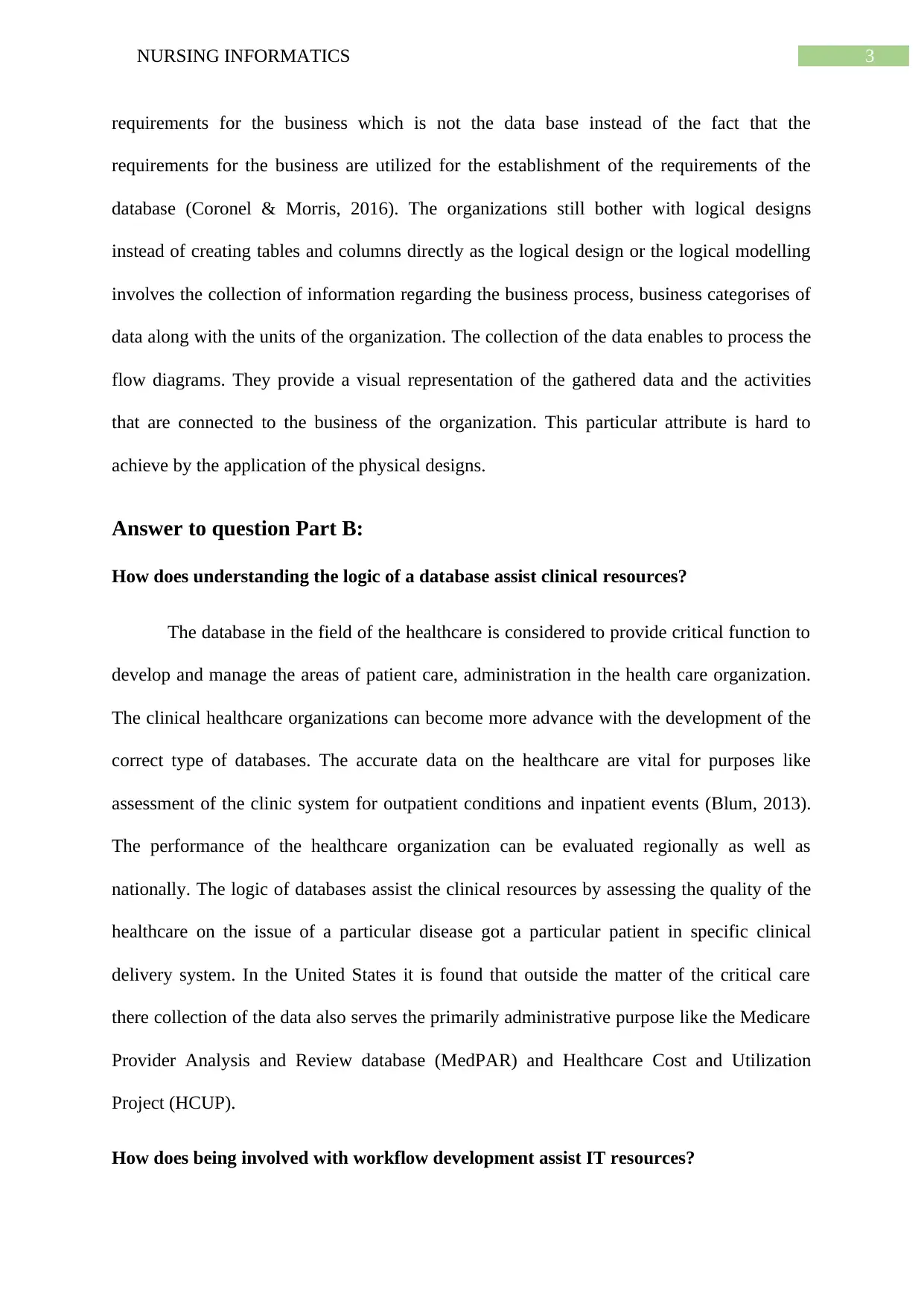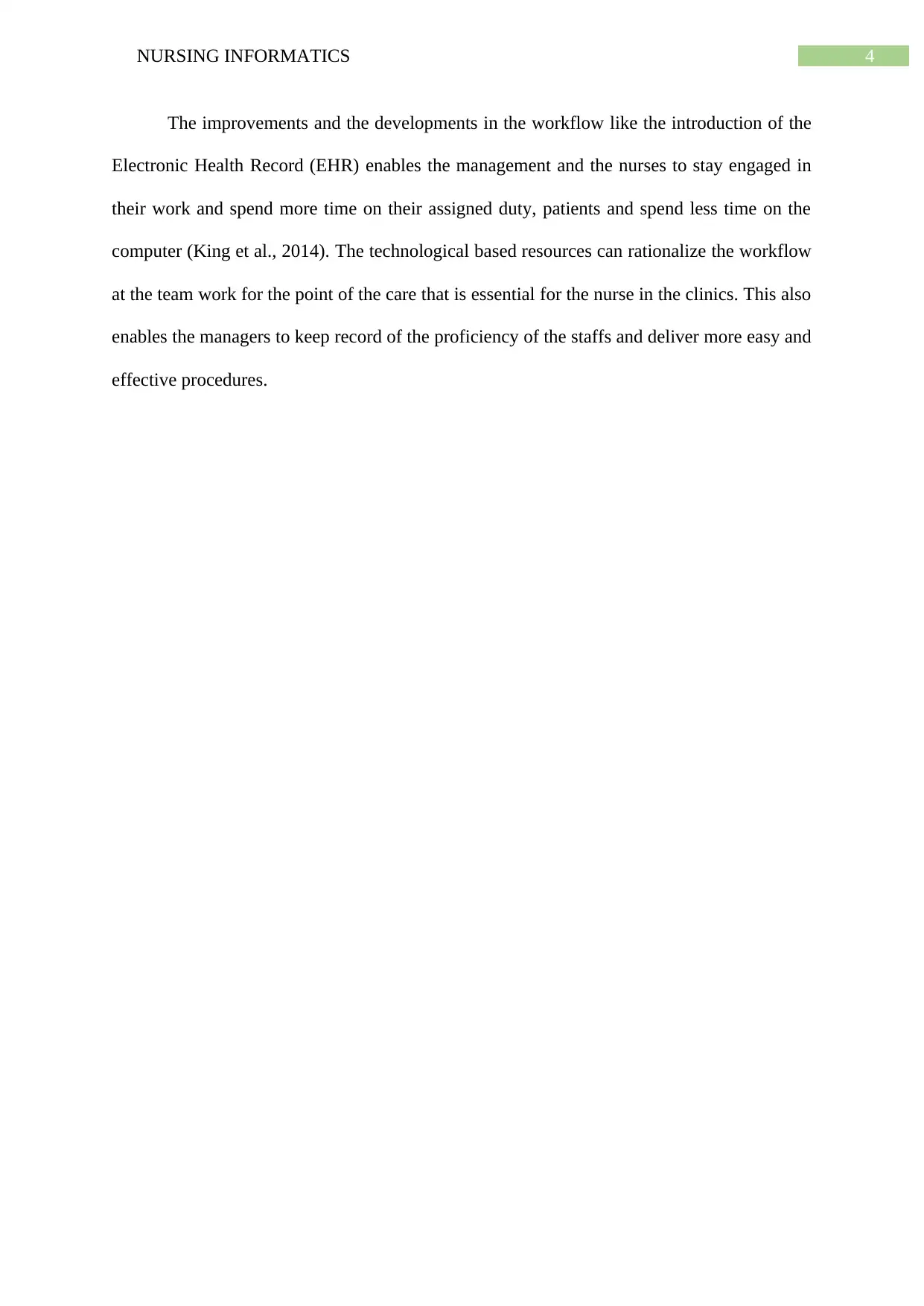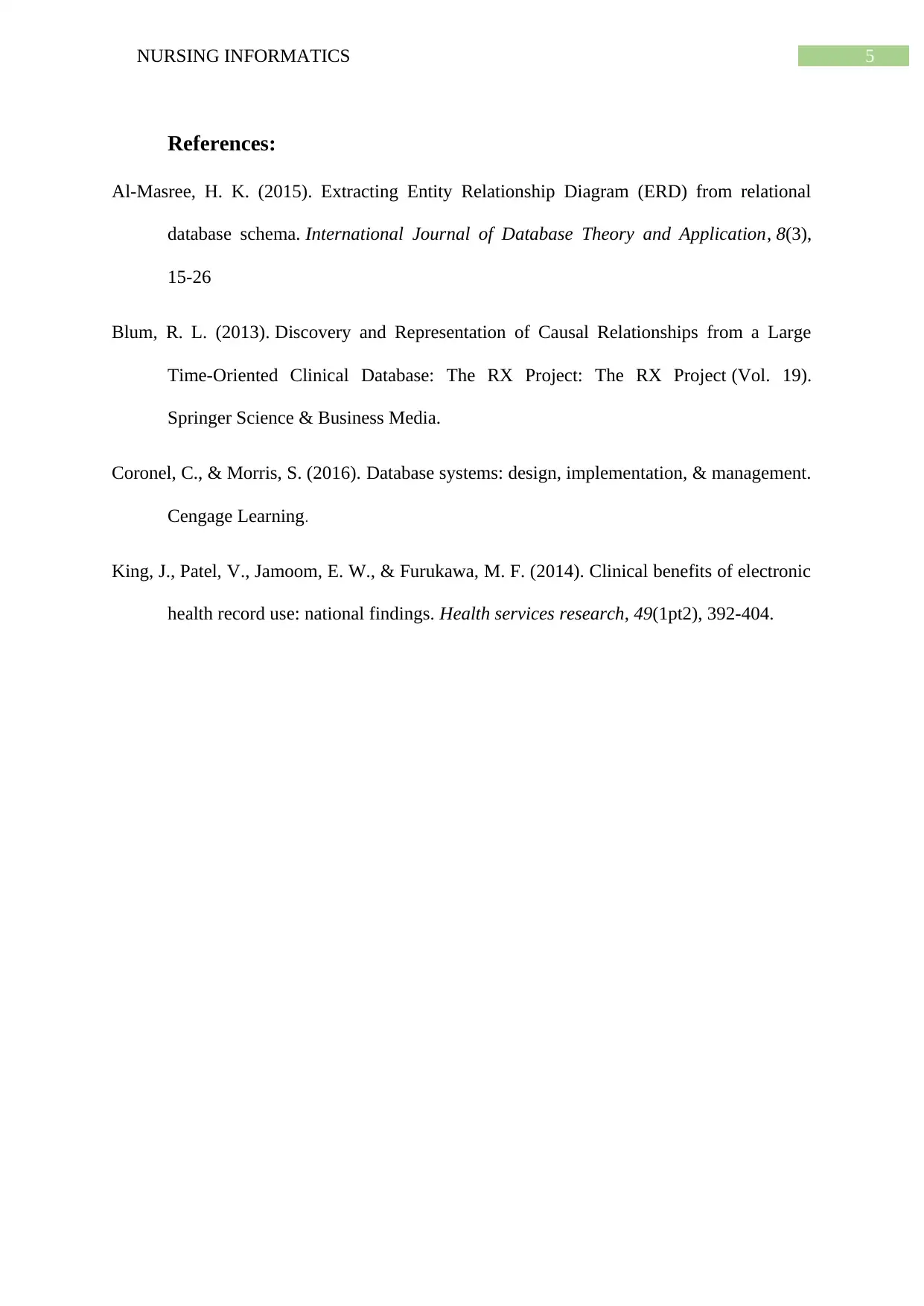Nursing Informatics: ER Diagrams, Database Logic, Workflow Development
VerifiedAdded on 2022/11/18
|6
|888
|347
Homework Assignment
AI Summary
This assignment delves into the core concepts of nursing informatics, addressing the benefits and drawbacks of ER diagrams in database design. It explores the rationale behind logical database design, contrasting it with physical design approaches. Furthermore, the assignment examines the crucial role of database logic in supporting clinical resources, emphasizing its impact on patient care and healthcare administration. It also analyzes the significance of workflow development, particularly the integration of EHR systems, and how it aids IT resources by streamlining processes and enhancing efficiency in healthcare settings. The assignment is well-researched and includes relevant academic references to support the discussed concepts.

Running head: NURSING INFORMATICS
NURSING INFORMATICS
Name of the Student
Name of the University
Author note
NURSING INFORMATICS
Name of the Student
Name of the University
Author note
Paraphrase This Document
Need a fresh take? Get an instant paraphrase of this document with our AI Paraphraser

1NURSING INFORMATICS
Table of Contents
Answer to question Part A: 2
Answer to question Part B: 3
References: 5
Table of Contents
Answer to question Part A: 2
Answer to question Part B: 3
References: 5

2NURSING INFORMATICS
Answer to question Part A:
What are the benefits or disadvantages of ER diagrams?
There are several benefits of the ER Model which are:
The ER Model allows the representation of the straightforward relation. When
ER Diagram is designed for the particular database application, the
representation format in a relational process for the database model relatively
becomes straight forward which benefits in achieving the output from the
database (Al-Masree, 2015).
The conversion method from the Entity Relationship model to any other
model as per requirement is easy and is not complex. The conversion process
or the converted result from the ER model to in any other model can be easily
achieved.
The objective of the ER model is also an advantage over other models which
states the graphical representation in the model for the better understanding.
The ER Model delivers graphical and diagrammatical representation of the
different entities including the attributes that states the relationship between
them. The graphical representation also enables the easy understanding of the
structure of the data. This type of the representation of the model reduces the
redundancy and many other difficulties.
Why bother with logical design and not just create tables and columns (physical
design) directly?
The part of logical modeling in the process of data modeling works in gathering the
requirements for the business process and converting those requirements of the business in
the form of a model. The objective of the logical designs in the model revolves around the
Answer to question Part A:
What are the benefits or disadvantages of ER diagrams?
There are several benefits of the ER Model which are:
The ER Model allows the representation of the straightforward relation. When
ER Diagram is designed for the particular database application, the
representation format in a relational process for the database model relatively
becomes straight forward which benefits in achieving the output from the
database (Al-Masree, 2015).
The conversion method from the Entity Relationship model to any other
model as per requirement is easy and is not complex. The conversion process
or the converted result from the ER model to in any other model can be easily
achieved.
The objective of the ER model is also an advantage over other models which
states the graphical representation in the model for the better understanding.
The ER Model delivers graphical and diagrammatical representation of the
different entities including the attributes that states the relationship between
them. The graphical representation also enables the easy understanding of the
structure of the data. This type of the representation of the model reduces the
redundancy and many other difficulties.
Why bother with logical design and not just create tables and columns (physical
design) directly?
The part of logical modeling in the process of data modeling works in gathering the
requirements for the business process and converting those requirements of the business in
the form of a model. The objective of the logical designs in the model revolves around the
⊘ This is a preview!⊘
Do you want full access?
Subscribe today to unlock all pages.

Trusted by 1+ million students worldwide

3NURSING INFORMATICS
requirements for the business which is not the data base instead of the fact that the
requirements for the business are utilized for the establishment of the requirements of the
database (Coronel & Morris, 2016). The organizations still bother with logical designs
instead of creating tables and columns directly as the logical design or the logical modelling
involves the collection of information regarding the business process, business categorises of
data along with the units of the organization. The collection of the data enables to process the
flow diagrams. They provide a visual representation of the gathered data and the activities
that are connected to the business of the organization. This particular attribute is hard to
achieve by the application of the physical designs.
Answer to question Part B:
How does understanding the logic of a database assist clinical resources?
The database in the field of the healthcare is considered to provide critical function to
develop and manage the areas of patient care, administration in the health care organization.
The clinical healthcare organizations can become more advance with the development of the
correct type of databases. The accurate data on the healthcare are vital for purposes like
assessment of the clinic system for outpatient conditions and inpatient events (Blum, 2013).
The performance of the healthcare organization can be evaluated regionally as well as
nationally. The logic of databases assist the clinical resources by assessing the quality of the
healthcare on the issue of a particular disease got a particular patient in specific clinical
delivery system. In the United States it is found that outside the matter of the critical care
there collection of the data also serves the primarily administrative purpose like the Medicare
Provider Analysis and Review database (MedPAR) and Healthcare Cost and Utilization
Project (HCUP).
How does being involved with workflow development assist IT resources?
requirements for the business which is not the data base instead of the fact that the
requirements for the business are utilized for the establishment of the requirements of the
database (Coronel & Morris, 2016). The organizations still bother with logical designs
instead of creating tables and columns directly as the logical design or the logical modelling
involves the collection of information regarding the business process, business categorises of
data along with the units of the organization. The collection of the data enables to process the
flow diagrams. They provide a visual representation of the gathered data and the activities
that are connected to the business of the organization. This particular attribute is hard to
achieve by the application of the physical designs.
Answer to question Part B:
How does understanding the logic of a database assist clinical resources?
The database in the field of the healthcare is considered to provide critical function to
develop and manage the areas of patient care, administration in the health care organization.
The clinical healthcare organizations can become more advance with the development of the
correct type of databases. The accurate data on the healthcare are vital for purposes like
assessment of the clinic system for outpatient conditions and inpatient events (Blum, 2013).
The performance of the healthcare organization can be evaluated regionally as well as
nationally. The logic of databases assist the clinical resources by assessing the quality of the
healthcare on the issue of a particular disease got a particular patient in specific clinical
delivery system. In the United States it is found that outside the matter of the critical care
there collection of the data also serves the primarily administrative purpose like the Medicare
Provider Analysis and Review database (MedPAR) and Healthcare Cost and Utilization
Project (HCUP).
How does being involved with workflow development assist IT resources?
Paraphrase This Document
Need a fresh take? Get an instant paraphrase of this document with our AI Paraphraser

4NURSING INFORMATICS
The improvements and the developments in the workflow like the introduction of the
Electronic Health Record (EHR) enables the management and the nurses to stay engaged in
their work and spend more time on their assigned duty, patients and spend less time on the
computer (King et al., 2014). The technological based resources can rationalize the workflow
at the team work for the point of the care that is essential for the nurse in the clinics. This also
enables the managers to keep record of the proficiency of the staffs and deliver more easy and
effective procedures.
The improvements and the developments in the workflow like the introduction of the
Electronic Health Record (EHR) enables the management and the nurses to stay engaged in
their work and spend more time on their assigned duty, patients and spend less time on the
computer (King et al., 2014). The technological based resources can rationalize the workflow
at the team work for the point of the care that is essential for the nurse in the clinics. This also
enables the managers to keep record of the proficiency of the staffs and deliver more easy and
effective procedures.

5NURSING INFORMATICS
References:
Al-Masree, H. K. (2015). Extracting Entity Relationship Diagram (ERD) from relational
database schema. International Journal of Database Theory and Application, 8(3),
15-26
Blum, R. L. (2013). Discovery and Representation of Causal Relationships from a Large
Time-Oriented Clinical Database: The RX Project: The RX Project (Vol. 19).
Springer Science & Business Media.
Coronel, C., & Morris, S. (2016). Database systems: design, implementation, & management.
Cengage Learning.
King, J., Patel, V., Jamoom, E. W., & Furukawa, M. F. (2014). Clinical benefits of electronic
health record use: national findings. Health services research, 49(1pt2), 392-404.
References:
Al-Masree, H. K. (2015). Extracting Entity Relationship Diagram (ERD) from relational
database schema. International Journal of Database Theory and Application, 8(3),
15-26
Blum, R. L. (2013). Discovery and Representation of Causal Relationships from a Large
Time-Oriented Clinical Database: The RX Project: The RX Project (Vol. 19).
Springer Science & Business Media.
Coronel, C., & Morris, S. (2016). Database systems: design, implementation, & management.
Cengage Learning.
King, J., Patel, V., Jamoom, E. W., & Furukawa, M. F. (2014). Clinical benefits of electronic
health record use: national findings. Health services research, 49(1pt2), 392-404.
⊘ This is a preview!⊘
Do you want full access?
Subscribe today to unlock all pages.

Trusted by 1+ million students worldwide
1 out of 6
Related Documents
Your All-in-One AI-Powered Toolkit for Academic Success.
+13062052269
info@desklib.com
Available 24*7 on WhatsApp / Email
![[object Object]](/_next/static/media/star-bottom.7253800d.svg)
Unlock your academic potential
Copyright © 2020–2025 A2Z Services. All Rights Reserved. Developed and managed by ZUCOL.





